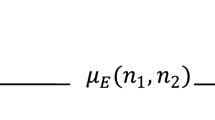Abstract
The knowledge of key network members is generally known to be critical to fuzzy social network analysis. Thus far, most studies aiming to identify critical members have taken network structural centrality measures. Since fuzzy graph cannot effectively depict the multidimensional relationships between the nodes of fuzzy social networks, a fuzzy social network model is developed complying with a mathematical theory of fuzzy hypergraph, allowing fuzzy social network to be represented more intuitively and visually. A fuzzy hypergraph model of fuzzy social network refers to a structure, vertex set acts as an object set, and the fuzzy relation in fuzzy relation structure is expressed by membership function and fuzzy relation matrix. With the fuzzy hypergraph model of fuzzy social networks, the definitions of structural centrality are given (i.e., degree centrality, relative degree centrality, closeness centrality, relative closeness centrality, betweenness centrality and relative betweenness centrality). Lastly, by analyzing examples, the process of building fuzzy social network with fuzzy hypergraph and the calculation method of centrality are illustrated.




Similar content being viewed by others
References
Akkuzu G, Aziz B, Adda M (2019) A fuzzy modeling approach for group decision making in social networks. In: International conference on business information systems. Springer, Cham, pp 74–85
Amato F, Moscato V, Picariello A, Piccialli F, Sperl G (2018) Centrality in heterogeneous social networks for lurkers detection: an approach based on hypergraphs. Concurr Comp-Pract E 30(3):4188
Borgatti SP (2006) Identifying sets of key players in a social network. Comput Math Organ Theory 12:21–34
Brunelli M, Fedrizzi M, Fedrizzi M (2014) Fuzzy m-ary adjacency relations in social network analysis: optimization and consensus evaluation. Inf Fusion 17:36–45
Chen QS (2008) The solving algorithms and their applications for hypergraph path. Huazhong University of Science and Technology, Wuhan
Du W, He XC (2017) Common strategy to improve community detection performance based on the nodes’ property. CAAI Trans Intell Tech 2(2):68–72
Fan TF, Liau CJ, Lin TY (2007) Positional analysis in fuzzy social networks. In: IEEE International Conf on Granular Computing, 2007. IEEE, p 423
Freeman LC (1978) Centrality in social networks conceptual clarification. Soc Netw 1:215–239
Gianpiero C, Giampiero C, Davide C, Gentile T (2016) On the connection of hypergraph theory with formal concept analysis and rough set theory. Inf Sci 330:342–357
Goetschel RH (1995) Introduction to fuzzy hypergraphs and Hebbian structures. Fuzzy Sets Syst 76:113–130
Halim Z, Khattak JH (2019) Density-based clustering of big probabilistic graphs. Evol Syst 10(3):333–350
Halim Z, Waqas M, Baig AR, Rashid A (2017) Efficient clustering of large uncertain graphs using neighborhood information. Int. J Approx Reason 90:274–291
Halim Z, Ali O, Khan G (2019) On the efficient representation of datasets as graphs to mine maximal frequent itemsets. IEEE Trans Knowl Data Eng
Hanneman R, Riddle M (2005) Introduction to social network methods. University of California, Riverside
Hu RJ, Li Q, Zhang GY, Ma WC (2015) Centrality measures in directed fuzzy social networks. Fuzzy Inf Eng 7:115–128
Ignjatovic J, Ciric M, Bogdanovic S (2010) On the greatest solutions to weakly linear systems of fuzzy relation inequalities and equations. Fuzzy Sets Syst 161(24):3081–3113
Klein A, Ahlf H, Sharma V (2015) Social activity and structural centrality in online social networks. Telemat Inf 32:321–332
Kundu S, Pal SK (2015) FGSN: fuzzy granular social networks-model and applications. Inf Sci 314:100–117
Lee SHM, Cotte J, Noseworthy TJ (2010) The role of network centrality in the flow of consumer influence. J Consum Psychol 20:66–77
Lu Z, Zhang Q, Du X, Wu D, Gao F (2016) A fuzzy social network centrality analysis model for interpersonal spatial relations. Knowl-Based Syst 105:206–213
Madbouly MM, Essameldin R, Darwish S (2019) A modified fuzzy sentiment analysis approach based on user ranking suitable for online social networks. In: International conference on advanced intelligent systems and informatics. Springer, Cham, pp 340–349
Nieminen J (1974) On the centrality in a graph. Scand J Psychol 15(1):332–336
Oh GR, Cho CH (1994) Fuzzy hypergraph. J Korean Inst Intell Syst 4:3–8
Patino MS, Lozano A (2014) Shortest hyperpaths in a multimodal network for the public transportation system: central Southern Mexico City. Procedia-Soc Behav Sci 160:529–538
Raj ED, Babu LDD (2016) A fuzzy adaptive resonance theory inspired overlapping community detection method for online social networks. Knowl-Based Syst 113:75–87
Rangasamy P, Akram M, Thilagavathi S (2013) Intuitionistic fuzzy shortest hyperpath in a network. Inf Process Lett 113:599–603
Rashid A, Kamran M, Halim Z (2019) A top down approach to enumerate $\alpha $-maximal cliques in uncertain graphs. J Intell fuzzy syst 36(4):3129–3141
Tuan TM, Chuan PM, Ali M, Ngan TT, Mittal M (2019) Fuzzy and neutrosophic modeling for link prediction in social networks. Evol Syst 10(4):629–34
Vista A (2015) Mass media, the ’sensational message’, and metamorphic truths. Telemat Inf 32:416–423
Volpentesta AP (2008) Hypernetworks in a directed hypergraph. Eur J Oper Res 188:390–405
Wu J, Chiclana F (2014) A social network analysis trust-consensus based approach to group decision-making problems with interval-valued fuzzy reciprocal preference relations. Knowl-Based Syst 59:97–107
Xiao Y, Zhao H (2014) Analysing users behaviour in online social network based on hypergraph theory. Comput Appl Softw 31:50–54
Funding
This work is supported by National Natural Science Foundation of China (61763044), supported by the Fundamental Research Funds for the Central Universities (31920200065).
Author information
Authors and Affiliations
Corresponding author
Additional information
Publisher's Note
Springer Nature remains neutral with regard to jurisdictional claims in published maps and institutional affiliations.
Rights and permissions
About this article
Cite this article
Wang, Q., Gong, ZT. Structural centrality in fuzzy social networks based on fuzzy hypergraph theory. Comput Math Organ Theory 26, 236–254 (2020). https://doi.org/10.1007/s10588-020-09312-x
Published:
Issue Date:
DOI: https://doi.org/10.1007/s10588-020-09312-x




